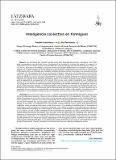Por favor, use este identificador para citar o enlazar a este item:
http://hdl.handle.net/10261/231711COMPARTIR / EXPORTAR:
 SHARE
BASE SHARE
BASE
|
|
| Visualizar otros formatos: MARC | Dublin Core | RDF | ORE | MODS | METS | DIDL | DATACITE | |

| Título: | Inteligència col·lectiva en formigues |
Autor: | Bartumeus, Frederic CSIC ORCID ; Fernández-López, Pol CSIC ORCID | Fecha de publicación: | 2021 | Editor: | Institució Catalana d'Història Natural | Citación: | L'Atzavara 31: 59-72 (2021) | Resumen: | [EN]Collective intelligence in ants. – Ants are very diverse social insects from both a taxonomical and an ecological perspective. However, they all share a particular form of organization: the colony. To guarantee the progress and survival of the colony, these animals perform simple tasks at the individual level (i.e. nest building, food collection and brood nursing) that end up benefiting the whole colony. Accordingly, ants do not act in isolation but communicate with one another and transfer the information so that the general activity of the colony is modulated and synchronised. A clear example occurs during food searching and collection: when a single ant discovers a new food source, it is capable of mobilizing tens to thousands of individuals in order to exploit this resource efficiently. This collective behaviour has attracted the interest of many researchers belonging to a wide range of disciplines. In the context of cognitive sciences, the activity of a colony of ants is often compared to the computational capability of a brain. Along these lines, the mathematical frameworks that explain how the brain works are also useful for modelling ants’ activity. The behaviour of these animals has inspired the development of algorithms that we commonly use, for instance, during internet searches. In our laboratory, we aim to further the understanding of the mechanisms underlying the dynamics of a whole ant society, depending on the ecological context. Therefore, we rely on new experimental methods that allow us to obtain high-quality data that can be used in well-established mathematical frameworks. Overall, we expect to help discover how ant collective intelligence works.[CAT]Les formigues són insectes socials d’una gran diversitat taxonòmica i ecològica, però totes elles comparteixen una particular forma d’organització en societat: la colònia. Per garantir el progrés i la supervivència de la colònia, aquests animals executen tasques senzilles de nivell individual (p.ex. construcció del niu, recol·lecció de menjar, cura de les larves) que acaben repercutint en un benefici col·lectiu. Les tasques no es desenvolupen de forma aïllada sinó que existeixen mecanismes de comunicació i transmissió d’informació entre els individus que modulen l’activitat de tota la colònia i permeten una resposta síncrona i coherent. Un clar exemple, és la cerca i recol·lecció d’aliment: quan una sola formiga troba una font d’aliment, és capaç de mobilitzar per mecanismes diferents desenes, centenars o milers d’individus per explotar de forma eficient un recurs. Aquest comportament col·lectiu és objecte d’interès en àmbits de recerca ben diferents. En l’àmbit de les ciències cognitives, sovint es compara l’activitat d’una colònia de formigues amb la capacitat de processament d’un cervell. Tant és així, que models matemàtics que s’utilitzen per explicar el funcionament del cervell, són també aplicables a una colònia de formigues. El comportament de les formigues ha inspirat el desenvolupament d’algoritmes que utilitzem diàriament, per exemple, durant la cerca d’informació per Internet. Al nostre laboratori volem contribuir a entendre els mecanismes de comportament que modulen la dinàmica de tota la colònia a partir del context ecològic. Per això, apostem per la generació de nous dissenys experimentals que permeten obtenir dades d’alta qualitat, tractables en marcs matemàtics i de modelització adequats per tal d’esbrinar com funciona la seva intel·ligència col·lectiva. | Descripción: | Este artículo contiene 14 páginas, 5 figuras, 2 tablas. | Versión del editor: | https://doi.org/10.2436/20.1502.atz31.059 | URI: | http://hdl.handle.net/10261/231711 | ISSN: | 0212-8993 2339-9791 |
| Aparece en las colecciones: | (CEAB) Artículos |
Ficheros en este ítem:
| Fichero | Descripción | Tamaño | Formato | |
|---|---|---|---|---|
| Bartumeus 2020.pdf | 1,48 MB | Adobe PDF |  Visualizar/Abrir |
CORE Recommender
NOTA: Los ítems de Digital.CSIC están protegidos por copyright, con todos los derechos reservados, a menos que se indique lo contrario.
